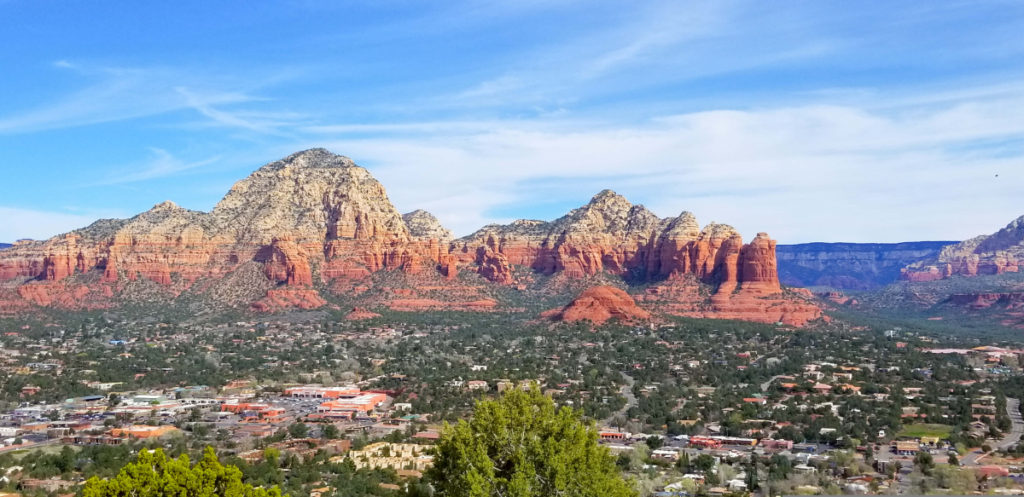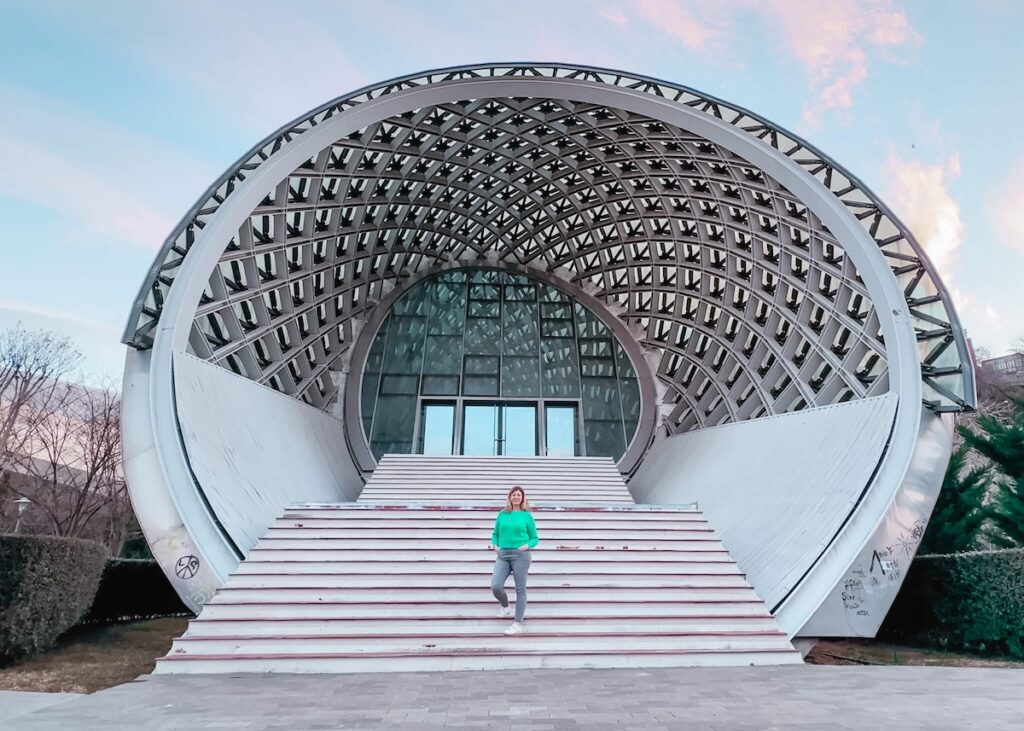
This Tbilisi itinerary will take you on an incredible journey through one of the world’s most fascinating cities.
Nestled amidst the Caucasus Mountains, Tbilisi is a city brimming with charm, history, and a touch of the unexpected.
Imagine strolling through cobbled streets lined with ancient churches, indulging in mouthwatering cuisine unique to the region, and while surrounded by incredible moutain views.
If I’m being honest, I was kind of blown away by how cool of a city Tbilisi is. Its people are kind, it’s food is delicious, and it’s historic Old Town is simply gorgeous.
Some of my favorite memories from my time in Tbilisi were the hours I spent walking it’s streets in the early morning. There’s something to be said about experiencing a new city for the first time under the golden glow of sunrise.
For those of you planning your first visit here, expect to have a packed Tbilisi itinerary. There’s a lot to see, and you’ll probably leave wishing you had more time. I know I did.
Some of the links in the post are affiliate links. If you make a purchase through these links it helps to support this site at no extra cost to you.
Tbilisi Itinerary
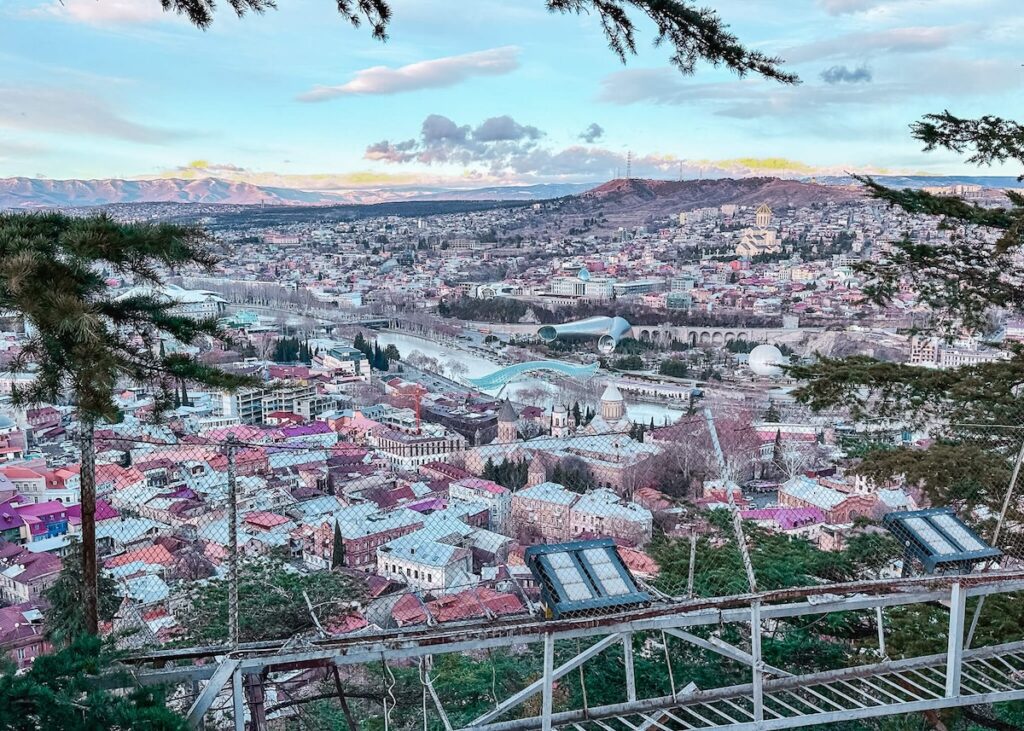
Tbilisi Georgia is a captivating city.
I think most will find Tbilisi is an easy city to navigate, especially when exploring Old Tbilisi. Most destinations are walkable, and those that aren’t are an affordable Bolt ride away.
If you’re looking to see the most popular sights in the city, I recommend booking a Tbilisi walking tour. This way you’ll learn about the history of the city from a local, while seeing the main attractions.
I recommend spending anywhere from three days in Tbilisi to a week or more. In three days you can do a good amount of sightseeing and get a feel for the city.
If you have more time than that, you can dive deeper into what makes Tbilisi so special. I’d also recommend a few day trips to other parts of Georgia. Both Sighnagi and Mtskheta are both amazing places to visit.
You’ll find hotel options all across the city in all budgets. I recommend staying near the Old Town so you can easily explore on foot and be close to the action.
This Tbilisi itinerary is intended to give you some ideas for your trip, but always be sure to make the trip your own and do what intersts you.
Food Tour
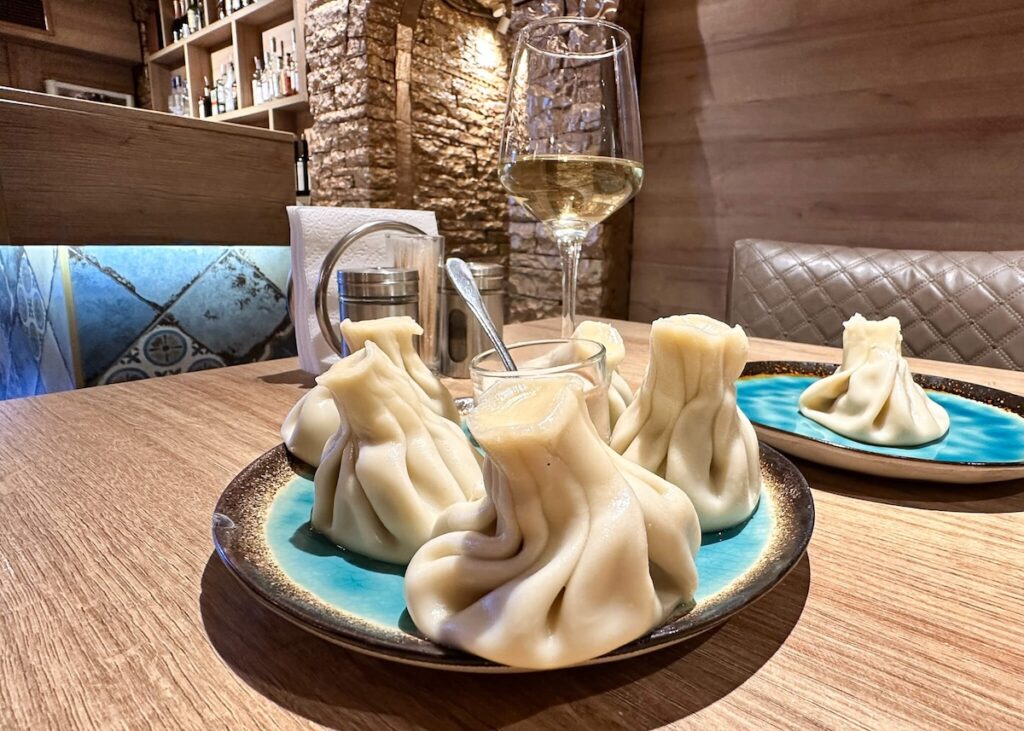
Under no circumstances can you come to Tbilisi and not explore the food and restaurant scene.
Georgia is known for it’s incredible cuisine, and there is plenty of it to be had here in Tbilisi. If possible, I highly recommend joining a Tbilisi food tour.
If you can’t join a guided food tour, make your own DIY food tour by visiting as many Tbilisi restaurants as possible.
Georgian cuisine has an emphasis on fresh ingredients, unique spices, and hearty portions. You will definitely not go hungry here, no matter your dietary preferences.
Tbilisi Restaurants
To get you started on the right path, here are a few of Tbilisi’s best restaurants to try during your visit.
OtsY
For an upscale experience, look no further than OtsY. Perched atop a hill, it offers panoramic city views alongside innovative takes on Georgian classics. Think succulent lamb dumplings (khinkali) bathed in creamy walnut sauce or melt-in-your-mouth khachapuri, a cheesy bread sensation.
Amra
For a taste beyond Tbilisi, head to Amra. This cozy restaurant specializes in Abkhazian cuisine, offering dishes like achma, a layered cheese and bread lasagna that will tantalize your taste buds. Don’t miss the chance to try walnut paste with local honey, a sweet ending to a savory adventure.
Mapshalia
Delicious food doesn’t have to break the bank. Mapshalia serves some of the best khinkali in Tbilisi at unbelievably affordable prices. Choose from various fillings – meat, cheese, or potato – and pair them with a refreshing glass of Georgian lemonade.
Ninia’s Garden
Craving a charming outdoor setting? Ninia’s Garden beckons. Nestled in a lush courtyard, it’s the perfect spot for a leisurely lunch. Sample traditional dishes like charcuterie boards with local cheeses and cured meats, or savor a steaming bowl of mkhlebli, a cornmeal porridge that’s surprisingly comforting.
I recommend including a dinner out at a different restaurant for each night of your visit. These dinners don’t have to be expensive, but Tbilisi really shines during meal time, so don’t miss the experience.
If you don’t mind staying up a little later, add a little bar hopping to your Tbilisi itinerary as well. The nightlife scene here is quite impressive.
Tbilisi Cable Car
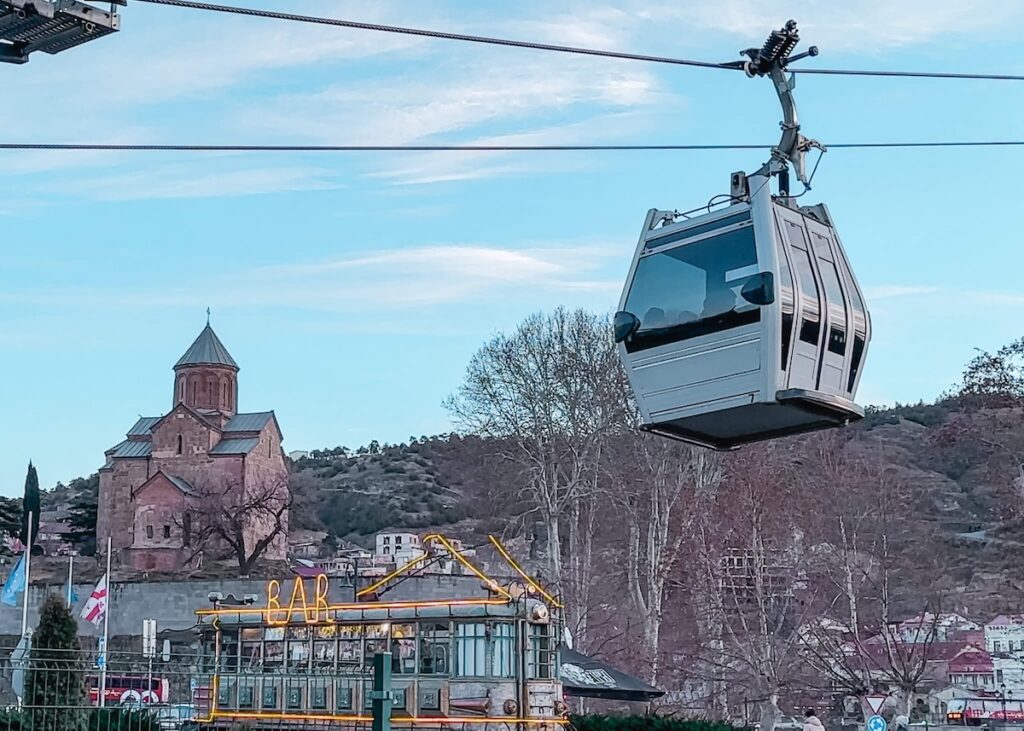
The Tbilisi Cable Car is a must have experience while visiting Tbilisi Georgia.
This modern marvel whisks you up to Narikala Fortress, granting breathtaking panoramic views and a quick adrenaline rush, all in one unforgettable journey.
Opened in 2012, the cable car quickly became a local favorite and is a must-do for tourists. It connects Rike Park, a vibrant green oasis on the banks of the Mtkvari River, with the historic Narikala Fortress perched high on a hill.
The ride itself is an experience itself as it steadily climbs the hill and offers ever expanind views of Tbilisi down below.
The cable car offers more than just stunning views, it’s a convenient way to access Narikla Fortress. This ancient citadel, with its winding cobblestone paths and stunning churches, offers a glimpse into Tbilisi’s rich past.
Explore its hidden corners, learn about its tumultuous history, and savor the panoramic views from the fortress walls. Afterwards, hop back in the cable car for a ride back down to Rike Park.
The Tbilisi Cable Car is an affordable adventure. Tickets are inexpensive, and the ride itself takes just a few minutes.
Mother of Georgia
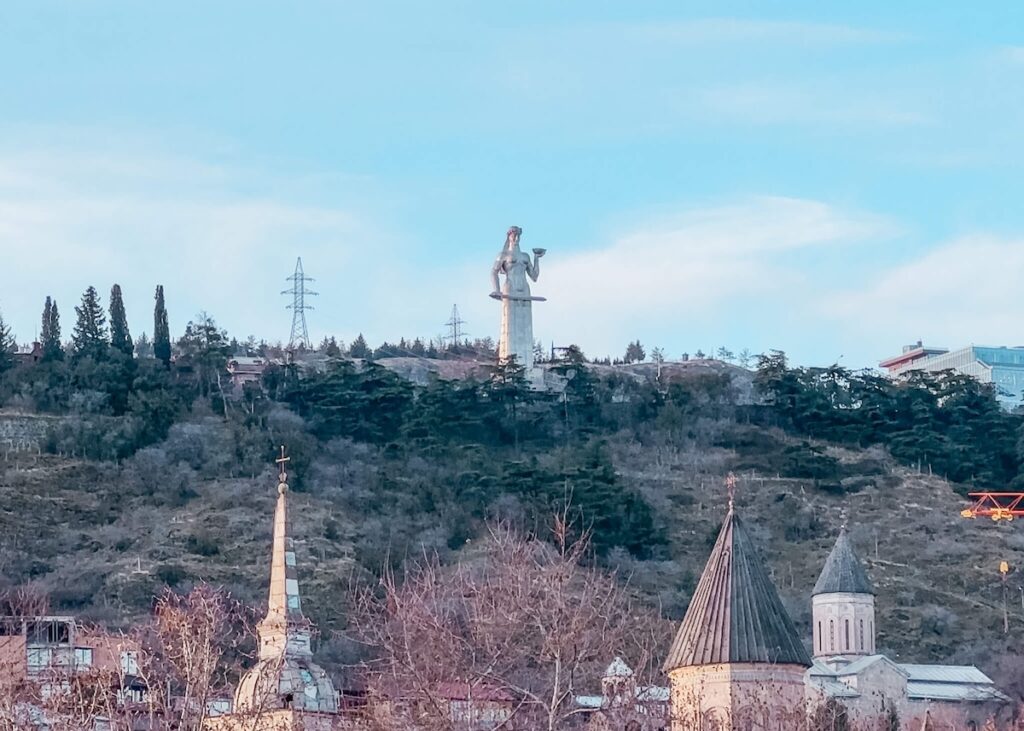
Towering over Tbilisi is the iconic Mother of Georgia statue, also known as Kartlis Deda. This 20-meter aluminum figure, clad in traditional Georgian attire, is more than just a landmark.
The Mother of Georgia statue is a powerful symbol of the country’s character and a source of national pride.
Designed by sculptor Elguja Amashukeli in 1958, the statue was erected to mark Tbilisi’s 1,500th anniversary. Originally crafted as a temporary wooden monument, her enduring popularity led to a permanent aluminum transformation in 1963.
Standing atop Sololaki Hill, the Mother of Georgia embodies the fierce spirit and unwavering hospitality that Georgians hold dear. In her right hand, she proudly raises a bowl overflowing with wine, a gesture of warmth and welcome to all who arrive as friends.
However, those who come with ill intentions beware. In her left hand, she grips a sword, a stark reminder of Georgia’s tumultuous history and its unwavering defense against invaders.
The statue’s location adds to its symbolism. Sololaki Hill was once a strategic military point, but now offers breathtaking panoramic views of Tbilisi.
Bridge of Peace
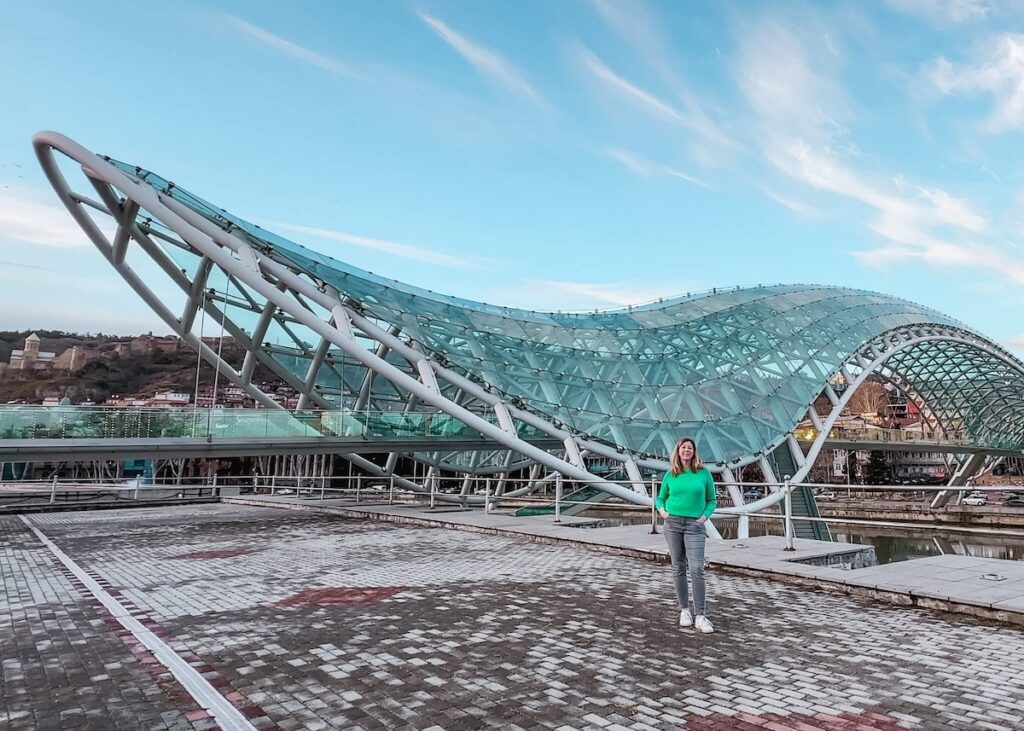
A Tbilisi itinerary would not be complete without a visit to the city’s famous bridge. The Bridge of Peace is a stunning architectural feat, a symbol of unity, and a vibrant landmark.
Designed by the Italian architect Michele De Lucchi, the bridge stretches gracefully over the Mtkvari River, connecting the historical Rike Park with the bustling Old Town. Its sleek, bow-shaped design mimics a wave or a sail, adding a touch of dynamism to the Tbilisi skyline.
As you step onto the bridge, the first thing that strikes you is the light. Over 12,000 LED bulbs are embedded within the bridge’s canopy, creating a mesmerizing spectacle after sunset.
Every hour, the lights come alive in a dazzling display, showcasing four distinct lighting programs.
Watch in awe as the bridge transforms with pulsating colors, creating a mesmerizing conversation in Morse code – a message about the elements that make up the human body, a symbolic ode to peace and unity.
The bridge itself is a pedestrian’s paradise. The wide, glass-paneled walkway offers breathtaking panoramic views of Tbilisi.
On one side, you can admire the historical gems of the Old Town, including the majestic Metekhi Church and the imposing Narikala Fortress.
Look the other way, and you’ll be greeted by the sleek architectural marvels of the new district, with the Presidential Palace standing tall.
Whether you’re captivated by the architectural marvel, mesmerized by the light show, or simply enjoy the chance to connect with the city’s pulse, the Bridge of Peace offers an unforgettable experience. It’s a testament to Tbilisi’s forward-thinking spirit, a place where history and modernity converge in a dazzling display of light and progress.
Rike Park
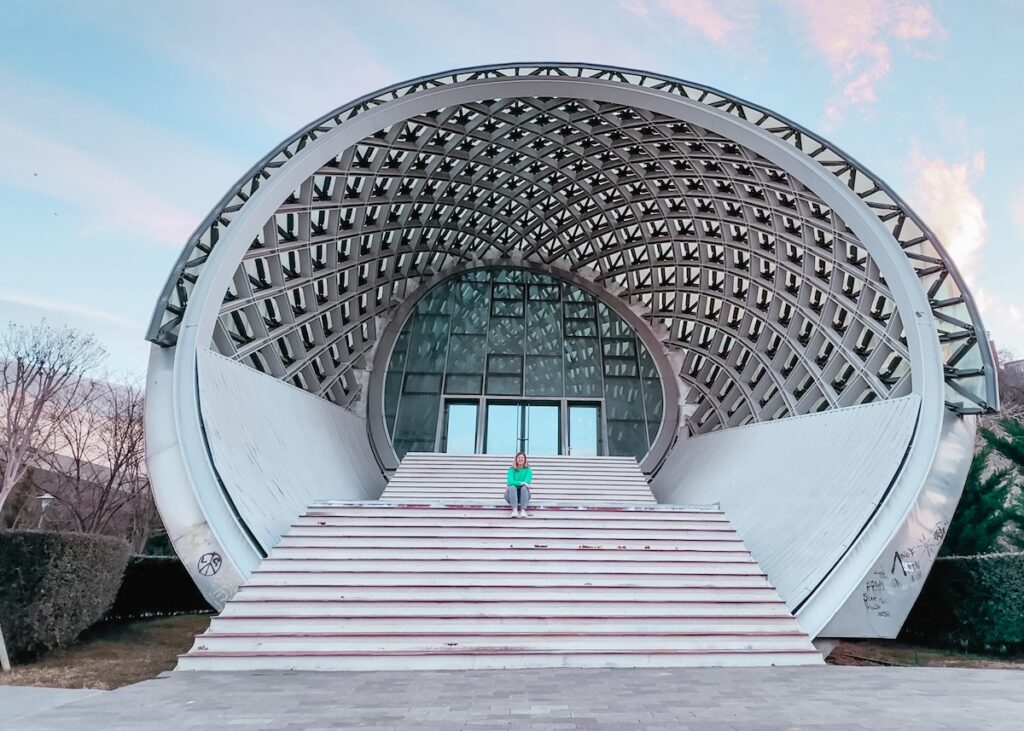
Nestled on the banks of the Mtkvari River in Tbilisi, Georgia, Rike Park offers a vibrant escape from the city’s bustling streets. This modern park, a haven for locals and tourists alike, is a delightful blend of leisure, art, and stunning cityscapes.
Step into Rike Park, and you’re greeted by a kaleidoscope of colors. Lush green lawns are dotted with vibrant flowerbeds, bursting with seasonal blooms.
This modern park offers a vibrant mix of activities for all ages. Here are a few things to do in Rike Park.
Bask in the sun on lush lawns, stroll through colorful flowerbeds, or unwind under shady palm trees. Rike Park is a haven for peace in the bustling city.
Challenge your friends to a giant chess game, let the kids loose on the modern playground, or snap a fun photo with the oversized piano. Playtime knows no age limit here!
Admire sculptures scattered throughout the park, or be mesmerized by the summer’s dancing fountains, a dazzling display of music, light, and water.
If you have the space in your Tbilisi itinerary I would try to see a performance at the Rike Music Theatre. The building is stunning and would be an incredibly unique experience to add to your trip.
Clock Tower
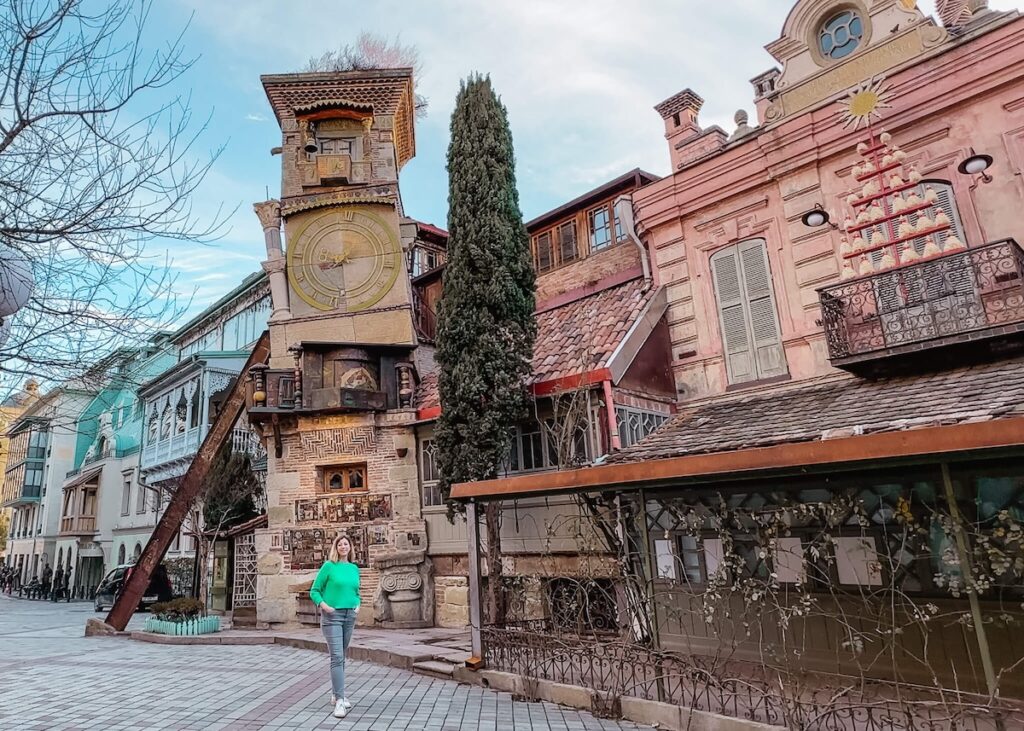
Tbilisi, Georgia, boasts a clock tower unlike any other. This whimsical structure, nestled beside the Rezo Gabriadze Theatre, injects a dose of quirky charm into the city’s historic Old Town.
The clock tower was constructed in 2010 and was the brainchild of renowned Georgian puppeteer Rezo Gabriadze.
It exudes a sense of playful theatricality that sets it apart. The tower itself leans precariously, creating a whimsical, almost fairytale-like atmosphere. Some say it’s a deliberate design choice, while others whisper tales of a mischievous spirit at work.
The real magic unfolds on the hour. A window near the top creaks open, revealing a small bronze angel. With a determined glint in its eye, the angel raises a hammer and strikes a resounding clang on the bell outside. It’s a delightful spectacle, a quirky performance that draws smiles from onlookers.
But the clock tower offers more than just a charming hourly show. Look closer, and you’ll see the tower adorned with hundreds of colorful tiles, each meticulously designed by Gabriadze himself. These tiles depict fantastical creatures and whimsical scenes, adding to the tower’s whimsical personality.
Venture inside, and you’ll discover a hidden gem: a miniature puppet theatre. Twice a day, the stage comes alive with Gabriadze’s captivating “Circle of Life” show. Witnessing this miniature masterpiece, played out against the backdrop of the quirky clock tower, is an unforgettable experience.
If you’d like to add this experience to your Tbilisi itinerary you find more information about the theatre here.
Sulphur Baths
A soak in Tbilisi’s historic sulfur baths is an experience you won’t want to leave out of your Tbilisi itinerary. These steaming havens, steeped in history and local tradition, offer a chance to relax, rejuvenate, and experience a slice of authentic Georgian culture.
For centuries, Tbilisi’s sulfur baths have been a social hub and a place of healing. Natural hot springs, rich in sulfur, bubble up from beneath the earth, feeding the bathhouses that line the Abanotubani district, the historic bath quarter.
The mineral-rich waters are said to have therapeutic properties, easing aches and pains. But the benefits go beyond the physical. Soaking in the warm water allows you to unwind, de-stress, and connect with a centuries-old tradition.
Some bathhouses offer additional treatments, like a traditional Georgian massage known as a “kisi.” A skilled masseuse will scrub your body with a special exfoliating mitt, leaving you feeling invigorated and renewed.
Beyond the individual experience, the bathhouses are a place for social interaction. Locals gather here to chat, gossip, and catch up with friends, creating a lively atmosphere. If you’re feeling adventurous, consider joining a communal bath, a separate section in some bathhouses where socializing takes center stage.
While the traditional bathhouses may seem rustic to some, there are also modernized options available. These establishments offer private bathing chambers with a more upscale ambiance, often featuring Jacuzzis, saunas, and even spa treatments.
When adding a visit to the sulfur baths to your Tbilisi itineary, be sure to book you reservation on line in advance if you opt for one of the luxurious options. The rooms can book up fast, especially during the weekend.
Holy Trinity Cathedral
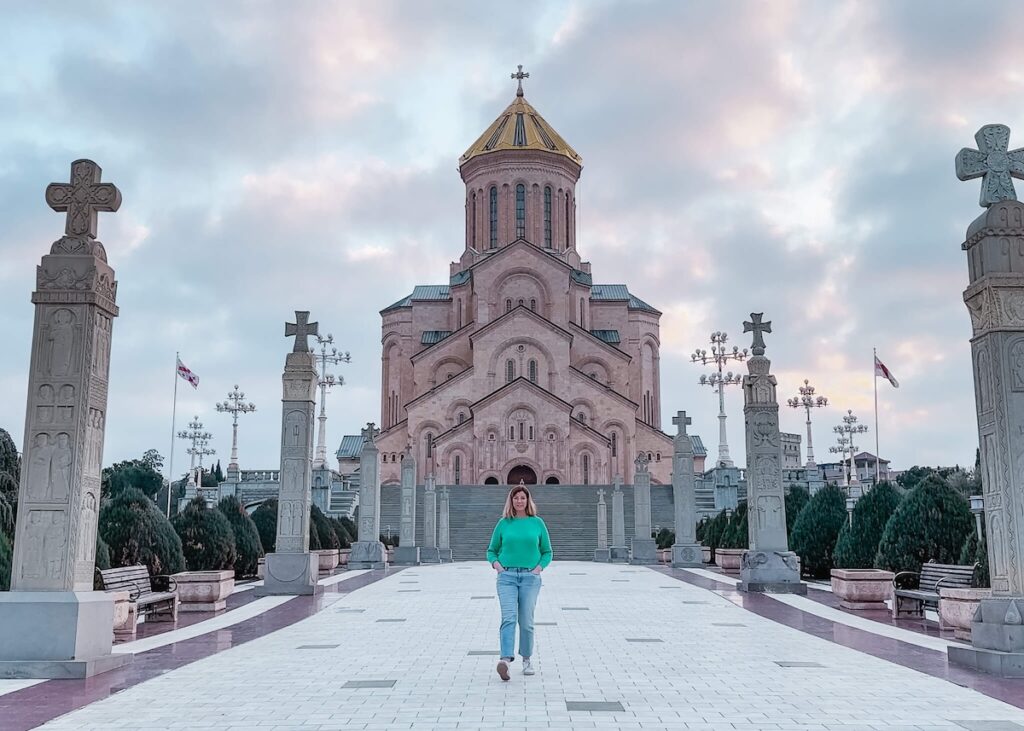
Towering over the Georgian capital, the Holy Trinity Cathedral, or Sameba as it’s affectionately known, isn’t just a magnificent architectural marvel, it’s a symbol of faith, history, and national pride.
This colossal structure, with its gleaming golden dome piercing the sky, has become synonymous with Tbilisi itself. Completed in 2004, Holy Trinity Cathedral is a relatively young landmark, but its design cleverly weaves together centuries of Georgian and Byzantine architectural traditions.
Standing tall on the banks of the Mtkvari River, the cathedral’s intricate facade features elegant arches and beautiful mosaics. Step inside, and the vastness of the space takes your breath away. Sunlight streams through stained glass windows, illuminating the frescoes that adorn the walls.
Freedom Square
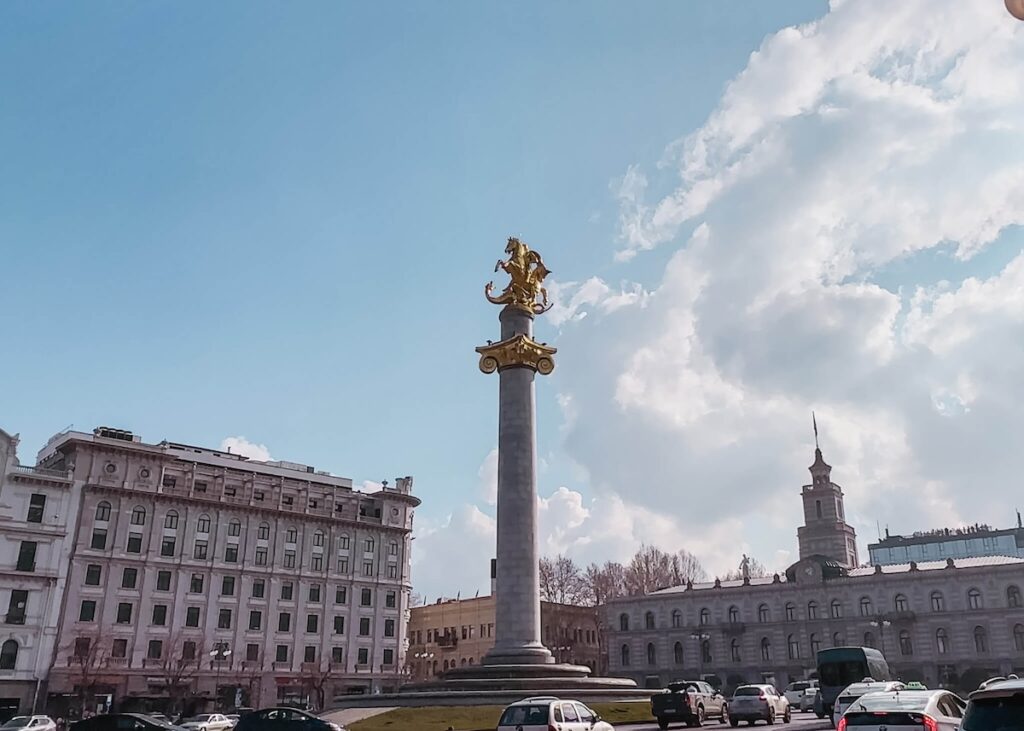
Tbilisi’s Freedom Square is symbolic of Georgia’s vibrant history. More than just a scenic landmark, it’s a stage where the nation’s fight for independence played out and continues to be celebrated.
The square’s very name reflects its significance. Formerly known as Lenin Square during the Soviet era, its 1991 renaming marked a symbolic victory. Today, the towering St. George slaying the dragon stands tall in the center, a national symbol of resilience.
Freedom Square has witnessed pivotal moments. Here, the declaration of independence from the Soviet Union was drafted, and the 2003 Rose Revolution, a peaceful uprising for democracy, unfolded. It’s a place where Georgians gather to celebrate national holidays, host concerts, or raise their voices in protest.
Beyond its historical weight, Freedom Square is a hub of daily life. Tourists flock to admire its architecture, locals relax on benches, and children chase pigeons. It’s a microcosm of Tbilisi, where the past and present converge.
Georgian National Museum
The Georgian National Museum is the place to visit if you want to learn more about the country’s history and culture. You’ll find many of Tbilisi’s most important musuems along Rustaveli Avenue, making it easy to visit a few museums in one afternoon.
It should be noted that the Georgian National Museum is not a single museum, it’s more like a network of museums. Each museum offers a distinct piece of Georgia’s fascinating history.
The beauty of the National Museum lies in its diversity. The Simon Janashia Museum of Georgia is the heart of the network, housing archaeological and ethnographic treasures.
Explore the Art Museum of Georgia, showcasing masterpieces from both Georgian and European artists.
For a thought-provoking experience, head to the Museum of the Soviet Occupation, a stark reminder of a tumultuous period in Georgia’s recent history.
Chronicles of Georgia
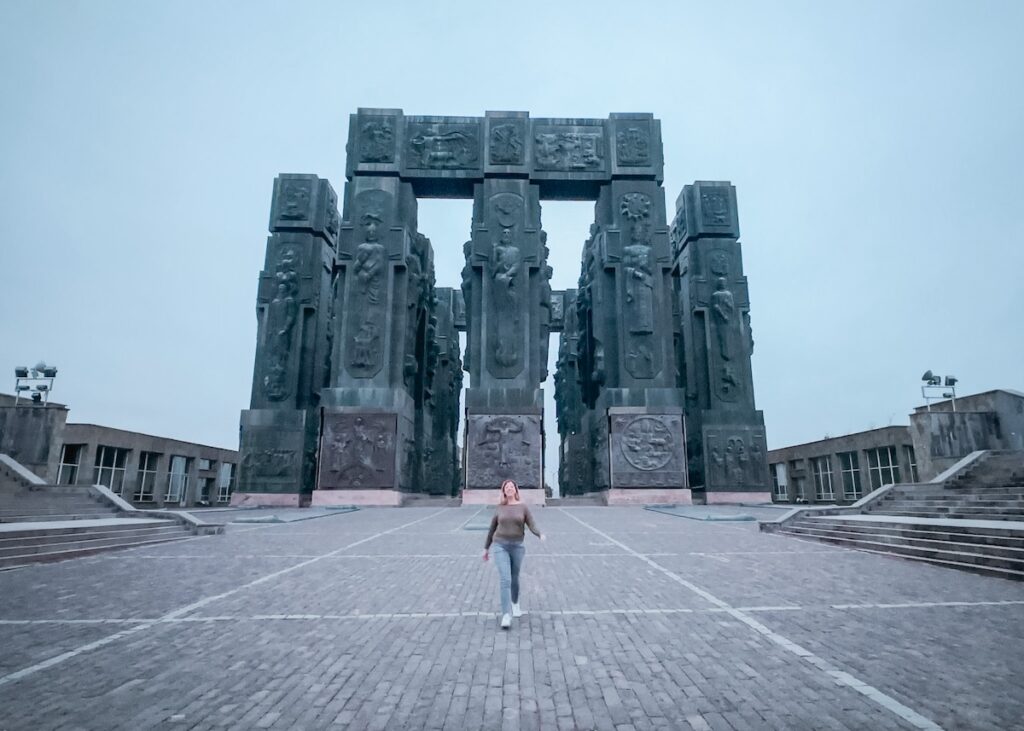
The Chronicles of Georgia is a massive monument perched on a hill overlooking the Tbilisi Sea.
Although located outside the city center, it’s worth adding to your Tbilisi itinerary. This is really cool to see in person and up close.
Designed by the controversial Georgian artist Zurab Tsereteli, the Chronicle is a fascinating work in progress. Construction began in 1985 to commemorate two major anniversaries: 3,000 years of Georgian statehood and 2,000 years of Christianity in the country.
Envisioned as a towering complex, it remains unfinished, yet its imposing presence is undeniable.
The climb to the Chronicle is a journey in itself. A long staircase leads you up the hill, offering a chance to catch your breath and admire the panoramic views of Tbilisi sprawling beneath you.
The city’s unique blend of Soviet-era architecture and modern buildings unfolds, with the vast Tbilisi Sea shimmering in the distance.
Reaching the top, you’re greeted by the centerpiece: 16 massive pillars, each reaching 30-35 meters high. These aren’t your typical, stoic columns. They’re wrapped in a narrative tapestry of bronze reliefs, depicting a rich history.
The upper halves showcase prominent figures – kings, queens, and national heroes – etched into the metal. Look closely, and you might recognize King Vakhtang Gorgasali, the legendary founder of Tbilisi.
I recommend waking up early and heading here for sunrise. You’ll likely have the place to yourself, and the sunrise views over Tbilisi are worth the effort.
I hope you’ve enjoyed this Tbilisi itinerary and that I’ve inspired you to plan a visit to this incedible city on your own. Thanks for reading.
Related Posts
Tbilisi Itinerary
This Tbilisi itinerary will take you on an incredible journey through one of the world’s…
Scottsdale to Sedona Day Trip Itinerary
Top 100 Highest Currency in the World in 2024
Photo by Canva This post will help you identify the top 100 highest currency in…

Eden Fite
Solo Traveler | Dog Lover | Avoider of CrowdsI help busy people find creative ways to travel more.
